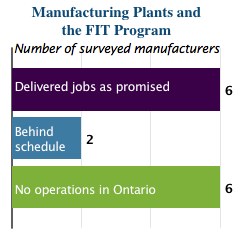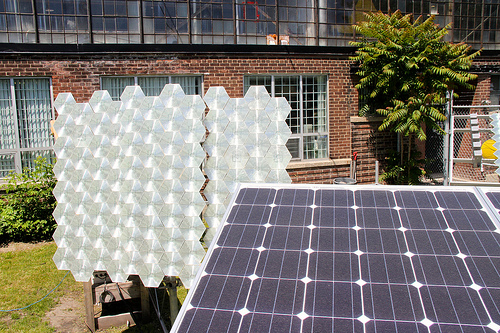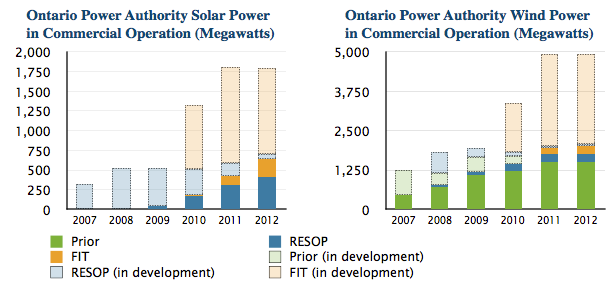It was one of the most ambitious renewable energy programs in the world when it launched in 2009, committing the Canadian province to buy power from thousands of new renewable energy systems. It was open and accessible to the average person, and it was committed to buying power only from projects that were “made in Ontario.” And it was part of a plan to kill off coal-fired power generation by the end of 2014.
Coal’s exit is still on schedule, but the rollout of renewables has been as rough as the Canadian Rockies.
The bottom line is that the Feed-In Tariff (FIT) program and its predecessors (despite facing significant threats) have jump-started renewable energy development in Ontario. The province would rank #4 and #11 for solar and wind deployment, respectively, if it were a U.S. state. It has created 31,000 jobs. 1 in 7 Ontario farmers is participating by producing renewable energy and earning a return on their investment. Coal power is disappearing from the province in about a year.
But despite some notable achievements, the province has struggled – fighting an international legal battle over its “buy local” policy, struggling with local utilities to get projects connected, and leaving thousands of prospective power producers languishing during long program reviews.
Read more in Expect Delays: Reviewing Ontario’s “Buy Local” Renewable Energy Program
Huge Interest
The biggest challenge for the FIT program is the overwhelming demand. Already, signed contracts for nearly 5,000 megawatts of new renewable energy capacity will allow the province to meet most of its 2030 renewable energy target, 12 years early. Actual deployment has kept pace with many U.S. states, but poor preparation has meant that less than 10% of energy under contract (thus far) is actually producing electricity.
Success with Small
The MicroFIT program (supporting mostly 10 kilowatt and smaller solar on homes and farms) has been a huge success. More than half of the 230 megawatts of solar added to the grid under the FIT program has been from the MicroFIT program. It’s also democratizing the Ontario energy system, by allowing over 15,000 individuals and small businesses to generate their own power.
Unexpected Challenges
With only 10% of proposed projects online in four years, the Ontario Power Authority has much to answer for. But it has also faced several additional challenges that may explain its difficulty in keeping up with demand:
- The world economy collapsed in late 2008, with a slow recovery.
- The ruling Liberal Party nearly lost its majority in the fall of 2011, jeopardizing support for the FIT program.
- The largest provincial utility, Hydro One, limited renewable energy to no more than 7% of peak demand on its distribution feeders and missed deadlines for interconnection, slowing energy deployment.
- In May 2013, Canada lost an appeal to a World Trade Organization suit challenging the program’s buy local provisions from Japan, the European Union, and the United States. In reply, the province dumped its “made in Ontario” rule.
Although these challenges piled on to the problems with rolling out the FIT program, they don’t excuse the poor performance of the Power Authority. The program review launched in 2011 left prospective energy producers hanging for nearly 18 months before the program reopened. Furthermore, the Power Authority ought to have learned from experience. The FIT program was an iteration of a similar standard offer program (called RESOP) offered from 2006 to 2008. Many of the problems with FIT could have been anticipated.
A Mixed Review on Jobs
The Energy Ministry says that 31,000 direct and indirect jobs have been created thus far by the Green Energy Act, far more than would be expected with less than 10 percent of the renewable energy deployed and despite the world economic slowdown. However, it’s quite a bit less than the 50,000 promised by 2012 when the program launched.
Manufacturing came to the province to serve the (now defunct) “buy local” provision. About half of surveyed manufacturers that indicated an intent to locate in Ontario have established a presence locally.
Doubling Down on Local
While Ontario energy officials abandoned the ‘buy local’ policy under international pressure, they have reinforced rules that prioritize local ownership of FIT projects. The success of the MicroFIT program and community-based projects led to a points scoring system for new FIT projects that rewards greater local support and local ownership.
The new rules will hopefully lead to more smaller-scale projects with support from the local community. A quarter of the program capacity opened in early 2013 was set aside for locally owned projects, but the total amount of new capacity was small. It’s not clear if the Power Authority intends to buy much more renewable energy capacity (and it certainly has many incomplete projects in the pipeline).
Conclusion: Improvements Needed
The successes for the province are clear: job creation on the backs of the ‘buy local’ policy and a surfeit of locally owned, small-scale energy production. But the failures are also clear: the Ontario Power Authority needs to get projects online by cutting red tape and pushing utilities to fulfill their obligations to connect renewable energy projects.
Ultimately, Ontario’s second iteration looks promising – a strong commitment to popular community-based energy development at a scale that can be developed rapidly. But it’s unclear if Ontario intends to really move megawatts of community energy or if the small amount permitting for round two indicates that community energy will live on the margins of Ontario’s energy system. Let’s hope they’ve learned their lessons.
For more on this subject, read ILSR’s report: Expect Delays: Reviewing Ontario’s “Buy Local” Renewable Energy Program
Like what you see? Get email updates on ILSR’s energy work!
Photo credit: Green Energy Futures



